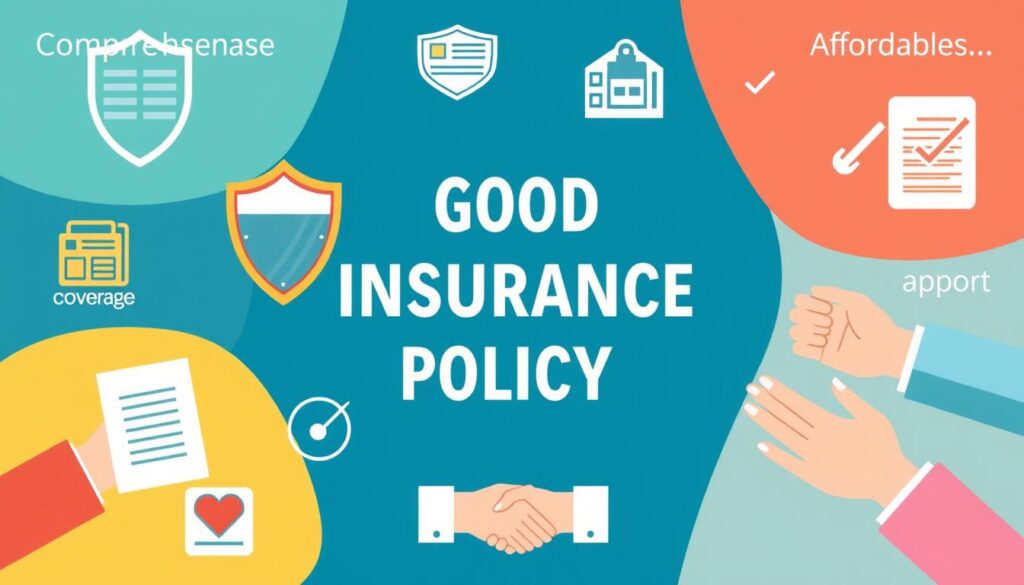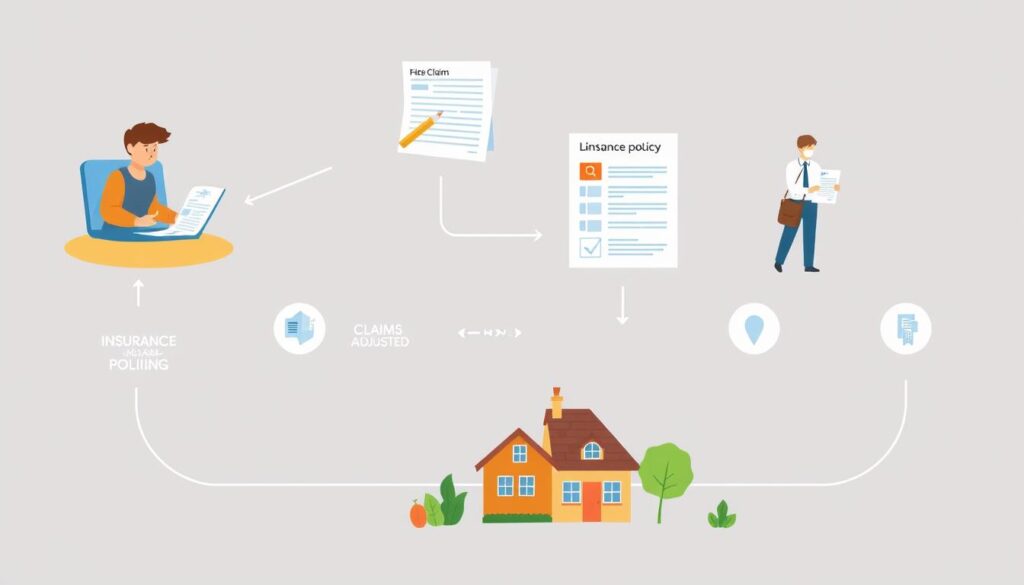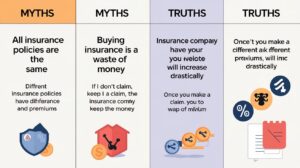What to Look for in a Good Insurance Policy: Tips for Beginners
Getting into insurance can feel overwhelming, especially if you’re new. Whether it’s for your home, car, or health, knowing what makes a good policy is key. This guide will help you understand the important factors to look for in an insurance plan.
Key Takeaways
- Understand the basic insurance terminology and concepts to make informed decisions.
- Evaluate coverage limits and deductibles to ensure adequate protection.
- Analyze premium costs and payment options to find the most affordable solution.
- Familiarize yourself with policy exclusions and limitations to avoid unexpected gaps in coverage.
- Research insurance companies’ financial strength to ensure the reliability of your provider.
Understanding Basic Insurance Terminology and Concepts
Getting into insurance can feel overwhelming, especially if you’re new. It’s key to learn about common terms and concepts. This will help you make better choices. Let’s look at the main terms and types of coverage you need to know.
Common Insurance Terms You Should Know
Knowing insurance jargon is the first step to finding the right policy. Some important terms include:
- Premium: This is what you pay for your insurance, usually monthly or yearly.
- Deductible: This is what you pay first before your insurance helps.
- Copay: A fixed cost you pay for services like doctor visits or prescriptions.
- Limit: The most your insurance will pay for a covered loss or claim.
Different Types of Insurance Coverage
There are many types of insurance policies, each for different risks. Some common ones are:
- Life insurance: It helps protect your loved ones if you pass away.
- Health insurance: It covers medical costs, like doctor visits and prescriptions.
- Auto insurance: It protects you from accidents and damages.
- Homeowner’s or renter’s insurance: It covers your belongings and liability in your home or rental.
How Insurance Policies Work
Insurance policies are contracts that explain what’s covered. When you pay your premium, you’re passing the risk to the insurance company. If something covered happens, the company will help pay for it, up to the policy limits.
Knowing about insurance terms and types helps you make smarter choices. By understanding these basics, you can confidently protect yourself and your loved ones.
| Term | Definition |
|---|---|
| Premium | The amount you pay for your insurance coverage, typically on a monthly or annual basis. |
| Deductible | The amount you must pay out of pocket before your insurance coverage kicks in. |
| Copay | The fixed amount you pay for a covered service or product, such as a doctor’s visit or prescription. |
| Limit | The maximum amount your insurance policy will pay for a covered loss or claim. |
Evaluating Coverage Limits and Deductibles
When picking an insurance policy, it’s key to look at coverage limits and deductibles closely. These parts are crucial for figuring out how much protection and cost you’ll get.
Coverage limits are the max your insurance will pay for a claim. Picking the right limits means you’re well-protected against accidents or surprises. Deductibles are what you pay first before your insurance helps.
Finding the right mix of coverage limits and deductibles is vital. Higher limits mean more protection but cost more. Lower deductibles mean less upfront cost but might cost more over time.
“Evaluating your coverage limits and deductibles is a crucial step in finding the right insurance policy for your needs and budget.”
When looking at policies, think about your risk level, money situation, and what could happen if you’re not insured. This helps you choose a policy that fits your needs and budget.
The aim is to find a balance between protection and cost. Take your time to compare options and pick a policy that suits your specific needs and situation.
Analyzing Premium Costs and Payment Options
Understanding insurance premiums is key to making smart choices. Knowing how rates are set and the payment options available helps you manage your budget. This section explores the details of insurance costs.
Factors Affecting Premium Rates
Many things affect your insurance rates. Your age, where you live, the coverage you pick, and your health risk are all important. Young people usually pay less, while older folks might pay more due to health concerns. Your location also matters, as some places have higher living costs or natural disaster risks.
Choosing the Right Payment Schedule
Insurance companies offer different ways to pay your premiums. You can pay yearly, every six months, every three months, or monthly. While paying yearly might save you a bit, smaller payments can help with your budget.
Understanding Premium Calculation Methods
Insurance companies use different ways to figure out your premium. These include risk-based, tiered, and usage-based pricing. Knowing these methods helps you understand why your premiums might change and how to choose the right coverage.
| Factor | Impact on Premiums |
|---|---|
| Age | Older individuals typically pay higher premiums |
| Location | Premiums may be higher in areas with higher cost of living or natural disaster risk |
| Type of Coverage | Comprehensive coverage generally has higher premiums than basic policies |
| Risk Profile | Individuals with higher risk factors may pay more for their insurance premiums |
By understanding what affects your insurance rates and the payment options, you can choose wisely. This way, you find coverage that fits your budget and needs.
What to Look for in a Good Insurance Policy: Tips for Beginners
When you’re new to insurance, it’s important to know what to look for. Look for a policy with comprehensive coverage, clear terms, and good conditions. These factors can greatly affect your protection and value.
First, make sure the policy covers what you need. This could be damage to property, liability, medical costs, or other risks. It’s key to understand what’s included and what’s not.
Also, the policy terms should be clear and easy to understand. You want to know your rights and what the insurer owes you. Avoid policies with confusing language that could cause problems later.
Lastly, check the policy’s conditions. Look for things like low premiums, flexible payments, and a good claims process. Comparing different policies can help you find the best one for your budget and needs.
By focusing on these key points, beginners can find a good insurance policy. This will help them feel protected and reduce stress.

Understanding Policy Exclusions and Limitations
When you buy an insurance policy, it’s key to know what it covers. Policies often have exclusions and limits that affect your coverage. Knowing these is crucial to get the protection you need.
Common Exclusions to Watch For
Insurance policies usually don’t cover certain events. This includes natural disasters, acts of war, and intentional acts. Always check your policy for these exclusions to see if they apply to you.
Reading the Fine Print
It’s important to read your policy’s terms and conditions carefully. The fine print lists what’s not covered and any limits. Make sure you understand what’s included and what’s not, including any costs you might have to pay.
Negotiating Coverage Terms
If the policy’s exclusions or limits don’t fit your needs, talk to your insurance provider. You might be able to add extra coverage. Discussing your needs with your representative can help you get the right protection.
By understanding exclusions, reading the fine print, and negotiating, you can choose a policy that fits you well.
| Policy Exclusion | Description | Potential Impact |
|---|---|---|
| Natural Disasters | Exclusions related to events such as earthquakes, floods, hurricanes, and tornadoes. | Homeowners may not be covered for damages caused by these types of natural disasters. |
| Acts of War | Exclusions for damages or losses resulting from wars, civil unrest, or terrorist attacks. | Policyholders may not be able to file a claim for damages or losses caused by these events. |
| Intentional or Criminal Acts | Exclusions for damages or losses caused by the policyholder’s intentional or criminal actions. | Policyholders may not be able to file a claim for damages or losses resulting from their own unlawful or intentional behavior. |
Researching Insurance Companies’ Financial Strength
When you invest in an insurance policy, checking the company’s financial health is key. Insurance company ratings and financial stability show if the insurer can pay claims. This is crucial for your protection.
To understand an insurance company’s financial strength, look at these factors:
- Financial Strength Ratings: Check ratings from A.M. Best, Moody’s, or Standard & Poor’s. These show if the insurer can meet its financial promises.
- Asset-to-Liability Ratio: A high ratio means the insurer has enough assets to cover its debts. This shows financial stability.
- Debt-to-Equity Ratio: A low ratio means the company has a good balance between debt and equity. This can help it stay strong over time.
- Customer Retention Rates: High rates show policyholders are happy with the service and claims payments.
By researching an insurance company’s financial strength, you can make a smart choice. Choose a provider that can protect you when you need it most.
“A strong financial position is the foundation of an insurance company’s ability to fulfill its promises to policyholders.”

Exploring Available Discounts and Bundling Options
Smart consumers look for ways to cut down on insurance costs. They take advantage of discounts and bundling deals. Insurance companies offer many discounts to help you save on insurance discounts. Also, combining policies can lead to even bigger savings through policy bundling.
Types of Insurance Discounts
Insurance companies have various discounts to lower your premiums. Here are some common ones:
- Safe driver discounts for those with clean driving records
- Homeowner discounts for bundling home and auto policies
- Good student discounts for younger policyholders maintaining high academic performance
- Loyalty program discounts for customers who have been with the same insurer for an extended period
- Discounts for installing safety features in your home or vehicle
Benefits of Policy Bundling
Policy bundling is a great way to save on insurance. By getting multiple policies, like home, auto, and life, from the same provider, you can get big discounts. Bundling not only saves you money but also makes managing your insurance easier.
Loyalty Program Advantages
Many insurance companies have loyalty programs for long-term customers. These programs offer special discounts, priority service, and more. By joining these programs, you get benefits beyond just saving money.
Looking into discounts and bundling can really help with insurance costs. Take time to research and compare what different providers offer. This way, you can find the best value for your insurance needs.
Navigating the Claims Process
Filing an insurance claim can seem daunting, but it can be straightforward with the right approach. Whether it’s your first time or you’ve done it before, knowing the key steps is crucial. It helps ensure a smooth and successful outcome.
The first step is to report the incident to your insurance provider as soon as you can. This starts the investigation and claim processing. Be ready to give detailed information about the event, like the date, time, location, and any supporting documents or evidence.
- Gather all necessary documentation: This includes police reports, repair estimates, receipts, and other materials that support your claim.
- Follow the insurance company’s instructions: Each provider has specific requirements or forms. Make sure to follow their guidelines to ensure your claim is processed efficiently.
- Communicate regularly with your insurance representative: Keep in touch with your claims adjuster, providing any extra information they ask for and tracking your claim’s progress.
- Be patient and persistent: The insurance claims process can take time. But don’t hesitate to follow up and advocate for your rights as a policyholder.
By understanding the key steps and being proactive, you can increase your chances of a positive outcome. This ensures your insurance coverage works for you when you need it most.

“The key to a successful insurance claim is preparation and communication. Stay organized, follow the provider’s guidelines, and don’t be afraid to ask questions along the way.”
Comparing Customer Service and Support Options
Choosing an insurance policy means looking at more than just coverage. Customer service and support are key. Quick claims, 24/7 help, and easy online tools can greatly improve your experience as an insurance customer.
Online Account Management Features
Top insurance companies have great online tools. These let you check your policy, track claims, and pay bills online. Look for secure storage, customization, and updates to make managing your insurance support easier.
24/7 Support Availability
- Having customer service available all the time is crucial, especially in emergencies.
- Check how easy it is to get help from your insurance company, like by phone, email, or chat.
- Good 24/7 support means you can get help whenever you need it.
Claims Processing Efficiency
Filing a claim should be quick and accurate. Look into how fast and well an insurance company handles claims. Fast and efficient claims help you get the help you need when you need it.
“Exceptional customer service is the cornerstone of a successful insurance business. When customers feel valued and supported, they’re more likely to remain loyal and advocate for the brand.”
By focusing on these areas, you can find an insurance company that offers great coverage and support. You deserve the best support options and online account management features.
Conclusion
Starting your journey to pick the right insurance policy is exciting. Remember, understanding insurance terms, coverage types, and policy structures is key. This knowledge helps you make choices that fit your needs and budget.
When choosing, look at coverage limits, deductibles, and premium costs. Also, consider payment options. This way, you get the protection you need without spending too much. Checking policy exclusions, insurance company ratings, and discounts is also important. It helps you find the best coverage for you.
The journey of insurance policy selection is about securing your financial future. It’s a chance to make informed insurance decisions and feel secure. With the tips from this article, you’re ready to find the right insurance for you.
FAQ
What should I look for when choosing an insurance policy?
When picking an insurance policy, look at a few key things. Check the coverage limits and deductibles. Also, consider the premiums and how you file claims. Look at what’s not covered and the company’s financial health.
See if they offer discounts and check what other customers say. Bundling policies can also save you money.
What are the common insurance terms I should know?
It’s good to know some basic insurance terms. These include deductible, premium, and coverage limits. Also, understand exclusions and the claims process.
Knowing these terms helps you make better choices about your insurance.
How do I determine the appropriate coverage limits and deductibles for my policy?
Finding the right coverage limits and deductibles depends on your needs and risk level. Think about the value of your stuff, your potential risks, and your budget. These factors help you choose the right policy for you.
What factors affect the premiums I’ll pay for my insurance policy?
Many things can change your insurance premiums. Your age, where you live, and your driving record matter. So does your claims history, coverage limits, and policy type.
Knowing these can help you find ways to lower your premiums.
What are some common exclusions to watch out for in an insurance policy?
Be careful of exclusions like pre-existing conditions and intentional acts. Also, watch out for natural disasters and high-risk activities. Always read your policy carefully to know what’s covered and what’s not.
How can I evaluate an insurance company’s financial strength and stability?
To check an insurance company’s financial health, look at their ratings from A.M. Best, Moody’s, and Standard & Poor’s. This shows if they can pay out claims. It’s important to choose a company that’s financially stable.
What types of discounts and bundling options are available for insurance policies?
Insurance companies offer discounts for safe driving, good credit, and bundling policies. They also have loyalty programs. Looking into these can help you save on your premiums.
What should I do if I need to file an insurance claim?
If you need to file a claim, follow your insurance provider’s steps. This usually means submitting a claim and providing documents. Cooperate with the process to get your claim settled quickly and smoothly.
How can I evaluate an insurance company’s customer service and support?
Look at the company’s customer service and support. Check if they offer 24/7 help and have online account management. Also, see how fast they process claims. Reading customer reviews can give you more insight.




